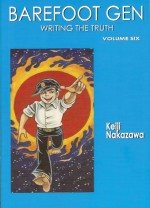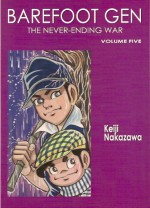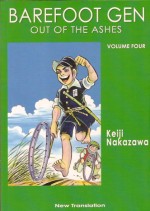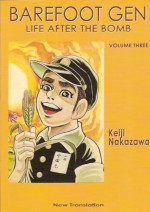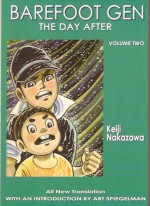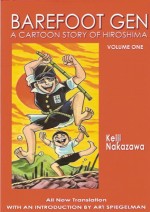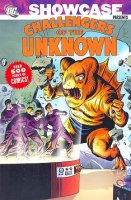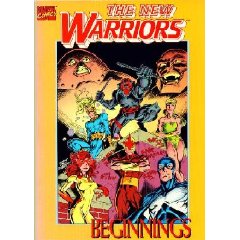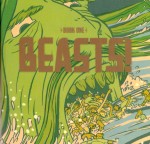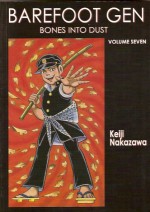
By Keiji Nakazawa (Last Gasp)
ISBN: 978-0-86719-598-9
As another day dawns in Keiji Nakazawa’s brilliant tribute to the endurance of the human spirit, the escaped prisoner Ryuta reveals a dark secret and turns it into a unique opportunity for Gen and his band of atomic survivors.
Before his incarceration Ryuta and other bomb orphans lived with an old man slowly dying, like so many others, from radiation poisoning. “Gramps” had one great wish: to publish a book about the Atom Bombing of Hiroshima. As his end approaches he has begun to despair. The American Occupation Forces suppress any discussion of the Bomb and its aftereffects so no Publisher will look at the manuscript and every printer in the recovering city is afraid of being charged with treason and espionage if they reproduce it.
Now Ryuta informs Gen that he has the solution. Japanese prisons are full of men from all trades, and have access to industrial machinery. The institutions must retrain and rehabilitate inmates whilst operating on very limited funds. Unscrupulous people “in the know” can get anything made in a prison if they know how to work the system – and can pay…
As so often the case in Gen’s life, the result falls into the category of Good News and Bad News. The prisoners will print the book, but only if Gen provides the paper. Once more the kids are scrabbling to find cash…
As they ponder how to get it they see a body floating in the river. For once it’s not a corpse and when they retrieve it Ryuta recognizes Noro, with whom he escaped from Shimane Reformatory. The lad is in a terrible state. When he had returned to the uncle who swindled him and put him in prison the old man set the dog on him…
Determined to help Noro – and themselves – the boys try to shame and defraud the old crook out of his money, but none of Gen’s extra-legal schemes ever work (only those that depend on grit, determination, ingenuity and honest toil) but when the rogue breaks down and tells his own tale of woe, a reconciliation is reached. With his inheritance returned the grateful Noro splits it three ways. They can buy paper now, if they can find a supplier…
At this point Korean black marketer Mr. Pak turns up again. The ex-slave labourer has prospered in the new, all-but lawless Hiroshima, and as the Nakaokas were the only people who ever treated him decently during the war, he will never accept their money. After relating his own experiences of those terrible times Pak’s only request is that the proposed book tells the truth about the war and the bombing – all of the truth…
At the height of the fourth summer after the detonation a small band of urchins collected a stack of freshly printed books from the back door of a prison and stacked them high on a hand cart.
“The End of Summer” by Matsukichi (Gramps) Hirayama is a condemnation of Man’s failings and yet a victory of the human spirit, and in a break from dragging it to the dying old man who wrote it, Gen reads a copy to his fellow child survivors. The savage, poetic testimony of the horror and even the old man’s private battles in the wake of the explosion reduces all of them to wracking tears. It also reinforces Gen’s fierce determination that it must never happen again.
But when they reach their shack the old man is dead.
Ryuta loses control in his frustration and grief, brutally pounding Gramps’ chest in uncontrollable fury. The old pain-dimmed eyes open! Was the old man in a deep coma, or did pride and love and rage drag his ghost back? It is a perfect affirmation: Never, Never, Never give up.
Within days the books are all gone and the truth about Hiroshima has begun its hand-to-hand travels across Japan. Gen, Musubi and Ryuta are still basking in a rare success when the American military police pounce, delivering them to the US Base at Kure and the tender mercies of Nisei (foreign born, second generation Japanese – in this case Japanese American) Officer Lieutenant Mike Hirota. He wants the author of The End of Summer and is prepared to do anything to get him. As usual Gen cannot be silenced and his accusatory confrontation with the face (a Japanese face not a white devil face) of the nation that used the bomb has been building for years…
The boys are thrown in a cell to await “Thought Modification”. It is already occupied by a severely beaten man who also refused to play ball with the Americans. Through broken lips he describes the treatment he received – chillingly similar to what detainees at Guantanamo Bay and Abu Ghraib have described in the most recent unpleasantness – to involve the UK and USA. The boys are terrified.
Nakazawa briefly digresses to relate the fate of author Wataru Kaji and the CIA precursor the Cannon Agency (“Canon Z-Unit”) in the Iwakasaki Mansion Scandal of 1953 (use your search engine or you could read Eiji Takamae and Robert Ricketts The Allied Occupation of Japan for more details), probably to show that militarists – and human nature – never changes before detailing the extreme measures the kids resort to in order to be freed…
Miraculously liberated, the kids use their newfound knowledge of how to sabotage engines to wage a small war of revenge on American vehicles…
When he finally goes home his mother is there and looking better than she has in years. His delight is short-lived as brother Akira explains that nobody ever recovers. If she’s home from hospital it can only be to die. The bittersweet weeks that follow are the most poignant yet as the children try to make her days perfect, and Mrs. Nakaoka’s shared memories of their father and his courtship, and even his brutal treatment as an anti-war activist, all serve to draw the family closer together.
When Koji finally returns from the coal mines the united Nakaoka clan go on one final trip together to the great Kiyomizu Temple at Kyoto where the parents spent their honeymoon – the happiest time of their lives…
The book closes with Gen’s reaction to his mother’s death, scenes I don’t have the words or the will to describe. It would be crass and you would not thank me.
Read this magnificent book. Read them all.
© 2008 Keiji Nakazawa. All Rights Reserved.

